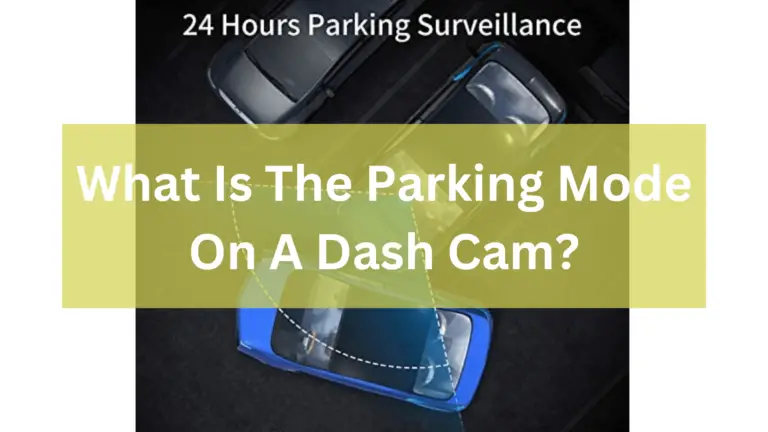How To Prevent Dash Cam From Draining Battery?
In the age of advanced technology, a dash cam has become an invaluable companion for drivers, offering security and peace of mind. However, as convenient as these devices are, there is a common concern among users: the fear of a dash cam draining the car’s battery when the vehicle is not in use.
Hardwiring your dash cam allows it to function when your car is off, providing a continuous power source without depleting your car’s battery. A hardwire kit is an essential tool for preventing your dash cam from draining your vehicle’s power.

In the following comprehensive guide, we will thoroughly explore the essential steps and discuss various strategies to minimize the impact of your dash cam on your vehicle’s battery life.
How Much Battery Power Does A Dash Cam Use?
Well, it depends on the specific model and configuration, but most dash cams generally have batteries ranging from 0.25 to 0.45Ah.
This seemingly small capacity might raise concerns about the dashcam’s ability to function efficiently for extended periods. However, it’s important to note that dash cams are primarily designed to be powered through the vehicle’s electrical system rather than relying solely on their built-in batteries.
The purpose of these batteries is usually twofold – providing backup power during short-term disruptions in power supply and ensuring proper shutdown after turning off the ignition.
How Long Does It Take For A Dash Cam To Drain A Car Battery?

It’s important to note that if your car battery is healthy and in good condition, it should be able to power the dashcam for at least a day or two in parking mode. However, several factors come into play that could affect the actual duration.
One major factor determining how long a dashcam can run in parking mode is the quality of the battery itself. A healthier battery with a higher capacity will naturally last longer than a weaker one. Additionally, newer cars often have more efficient electrical systems that minimize power consumption when the engine is off, which can extend the duration even further.
How To Reduce The Impact Of Dash Cam On Battery Life – 7 Tips

When using a dash cam, it is essential to be mindful of its impact on your vehicle’s battery. Constantly recording footage can drain the battery significantly, especially if you forget to turn off the camera when parking for extended periods. Here are some tips to help you reduce the impact of a dash cam on your battery life.
Select A Dash Cam That Is Energy Efficient
Choosing an energy-efficient dash cam is the first step in ensuring that your vehicle’s battery remains in good condition. Look for dash cams with advanced power management features that can optimize power usage. Additionally, consider models that utilize efficient chipsets and sensors, as these components can significantly impact a dash cam’s overall power consumption.
Choose A Dash Cam With Built-In Battery

Opting for a dash cam with a built-in battery can be advantageous for reducing its impact on your vehicle’s battery. A built-in battery allows the dash cam to operate even when the engine is off, drawing power from its internal source rather than your car’s battery. This can be particularly useful for parking mode recording and ensuring that your car starts reliably.
Use A Hardwired Dash Cam
Hardwiring your dash cam, as mentioned earlier, is a highly effective method for minimizing its impact on your vehicle’s battery. A hardwired dash cam connects directly to your car’s electrical system, ensuring it receives a constant power supply without draining the battery when the engine is off. This method allows for continuous recording without worry.
Go For A Low-Resolution Dash Cam

Consider opting for a dash cam with a lower resolution if you are primarily concerned about battery life. High-resolution cameras tend to consume more power, especially when recording at their maximum settings. Choosing a lower resolution can balance video quality and power efficiency, extending your dash cam’s operating time.
Choose A Dash Cam With A Parking Mode
Many modern dash cams come equipped with a parking mode feature. This mode allows the dash cam to enter a low-power state when the car is parked, activating only when it detects motion or an impact. By utilizing this feature, you can make sure that your dash cam conserves power during periods of inactivity, significantly reducing its impact on your vehicle’s battery.
Turn Off The Screen Display

Most dash cams feature a screen display that shows real-time footage or settings. However, this screen can consume a considerable amount of power. To minimize your dash cam’s power usage, consider turning off the screen display when not needed. Dash cams can continue to record even with the screen turned off, ensuring a longer battery life.
Set Up The Motion Detection
Enabling motion detection on your dash cam can be another effective way to reduce its impact on your vehicle’s battery. When in motion detection mode, the dash cam remains in a low-power state until it senses movement or an impact. This ensures that it doesn’t continuously draw power when the car is stationary, making it a practical choice for prolonged parking periods.
By following these seven tips, you can proactively decrease the impact of your dash cam on your vehicle’s battery life while still enjoying the benefits of continuous recording and added security on the road.
Final Thoughts: How To Prevent Dash Cam From Draining Battery?
Hardwiring your dash cam is a reliable and effective solution to prevent it from draining your car’s battery. By connecting the dash cam directly to a constant power source, you can ensure it continues operating even when your car is turned off. This eliminates the need to rely on the car’s battery for power, thus preventing any risk of drainage. Hardwiring provides continuous recording capabilities and peace of mind, knowing that your dash cam will always be ready to capture any vital footage.
So, if you want to avoid any inconvenience or potential problems caused by a drained battery, consider investing in a hardwiring kit for your dash cam today.




